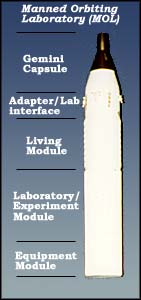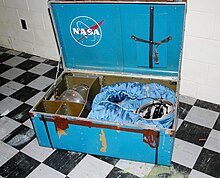Manned Orbiting Laboratory
The manned space laboratory Manned Orbiting Laboratory ( MOL ) of the USA was to serve as an espionage platform for the surveillance of the Soviet territory. It was part of the US Air Force's manned space program and was announced on December 10, 1963 as the successor to the discontinued X-20 Dyna-Soar program. However, the program was discontinued on June 10, 1969 without actual space flights having taken place. The missions were supposed to be started with a Titan IIIM missile, the development of which was however never completed.
The two-man crew of the MOL was to be launched together with the respective space laboratory in a modified Gemini spaceship , which was designated as the Gemini-B, and spend up to 40 days in space . The spaceship was firmly attached to the laboratory module and would not have been detached until the end of the mission in order to bring both the astronauts and the footage to Earth. A coupling of other spaceships, as is possible with space stations, was not intended here. After the crew returned, MOL could not have been manned again.
The espionage equipment of the MOL project was designated as KH-10 Dorian within the Keyhole reconnaissance satellite program . After the MOL program was discontinued, the reconnaissance tasks were carried out by the unmanned KH-9 hexagon satellites developed in parallel .
Test flight
The only actual space flight under the MOL program was the so-called MOL-HSQ mission (Manned Orbiting Laboratory- Heat Shield Qualification). This was a test flight of a MOL mockup to check the aerodynamic launch configuration and the modified heat shield of the Gemini-B spacecraft and took place on November 3, 1966 with a Titan IIIC rocket from Launch Complex 40 on Cape Canaveral . The landing capsule of the Gemini-B spacecraft was the Gemini-2 landing capsule flown before, and was placed in a suborbital trajectory while the dummy MOL reached orbit. Instead of the actual MOL, an empty Titan II fuel tank was used, which contained some technology experiments and was named "OV4-3" in orbit. During this mission, the three small research satellites OV1-6, OV4-1R and OV4-1T were also deployed.
Specifications
| crew | 2 astronauts |
| Maximum mission duration | 40 days |
| orbit | sun synchronous or polar |
| length | 21.92 m |
| diameter | 3.05 m |
| Cabin volume | 11.3 m³ |
| Dimensions | 14,476 kg |
| payload | 2,700 kg |
| power supply | Fuel cells or solar cells |
Astronauts
Eight astronauts were selected for the MOL project in 1965, five in 1966 and four in 1967.
| MOL Group 1 - November 1965 | MOL Group 2 - June 1966 | MOL Group 3 - June 1967 |
|---|---|---|
|
|
|
After the project was discontinued, NASA took over the seven astronauts of the project who were no more than 35 years old (Truly from Group 1, the entire Group 2 and Peterson from Group 3) - including Robert Crippen (pilot of the first Space Shuttle flight STS- 1 ) and Richard Truly (Director of NASA from 1989 to 1992). These seven astronauts all eventually flew into space as part of the space shuttle program; they provided (with the exception of Peterson) the pilots of the first six space shuttle flights and commanded a total of ten later missions.
Spacesuit
Little is known about the space suit of the MOL project, but in 2005 NASA employees rediscovered some stored specimens in a warehouse at the LC-5 / LC-6 of Cape Canaveral Air Force Station (CCAFS) in Florida.
See also
- Almas (Soviet military space station)
Web links
- MOL in the Encyclopedia Astronautica (English)
- Plan sketches
swell
- ↑ MOL space suits NASA, (English)








